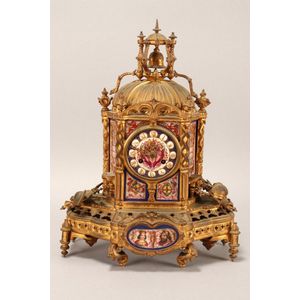Gothic-style French Japy Freres mantle clock with enamel dial
19th century French Japy Freres mantle clock, stamped Japy Freres, Grandperrin, a Paris to verso of ___4E1C00Af-D199-CA1D-0D3FE9D0BBB2FC3A___, the gilt brass case in the French Gothic architectural style with domed top surmounted by a bell and spire, featuring a polychrome enamel dial set with twelve convex cartouches containing Roman numerals, the case decorated with assorted enameled porcelain panels depicting Gothic tracery, dragons, heraldry and portraits, set between ormolu depicting weapons, shields and helmets above seven scrolled and tapered feet, a/f (parts missing), total height 47 x width 35 cm
You must be a subscriber, and be logged in to view price and dealer details.
Subscribe Now to view actual auction price for this item
When you subscribe, you have the option of setting the currency in which to display prices to $Au, $US, $NZ or Stg.
This item has been sold, and the description, image and price are for reference purposes only.
- Movement - The technical name for the workings of a clock or watch, and does not include the dial or case.
- A/f, as Inspected - The letters "A/F" or "as inspected" as part of a description is the cataloguer's shorthand for "all faults" or "as found", meaning the item has some type of damage or deficiency, it is of uncertain date or provenance, and/or that the seller takes no responsibility for the completeness of the item or the accuracy of the description.
- Polychrome - Made or finished in many colours. For furniture, it is used to indicated a painted finish.
- Ormolu - Ormolu was popular with French craftsmen in the 18th and 19th century for ornamental fittings for furniture, clocks and other decorative items. True ormolu is gilt bronze, that is bronze that has been coated with gold using a mercury amalgam. Due to the health risks associated with using mercury, this method of creating ormolu was discontinued in France in the 1830s. A substitute was developed consisting of about 75% copper and 25% zinc, however it was inferior to the bronze version. It was often lacquered to prevent it tarnishing.
- Verso - Verso is the "back" side of a sheet of paper, art work, coin or medal. The front side is "recto".
This item has been included into following indexes:
- clocks, mantle & shelf, material or style - gilt metal / ormolu 536
- clocks, mantle & shelf, period or origin
- Japy Freres / Japy & Cie (France) - clocks, maker or retailer 150
